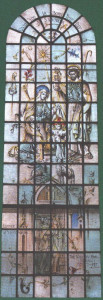In time-line sequence, the upper half of the second window relates the humble birth of our Lord in the manger of Bethlehem. Mary and Joseph attend Him, under the watchful eyes of two nearby sheep. The three perpendicular crowns on the right draw to mind the Three Kings who were en route to worship Him at the time of the nativity.
Hanging from a staff in the upper left portion of the window is the purse of St. James. Its presence, although open to interpretation, easily relates to the letter of James (1:9-11) in which he writes of the perishing rich and the exaltation of the humbler man.
The Reformation of the Church is portrayed by Martin Luther nailing his Ninety-five Theses on the door of the castle church at Wittenberg on All Saints’ Eve, October 31, 1517, marking new beginnings in Christianity. With Luther’s ensuing refusal to retract his stand on the sale of indulgences and other dogmatic teachings of the Church of Rome the following year at Augsburg, and the subsequent burning of the papal bull of excommunication in 1520, the outspoken German Augustinian monk assumed the role of protagonist of ecclesiastical reform and consequently ushered in a new era in Christianity.
Tying in with the theme of humble beginnings, Luther once stated in his Table Talk, (Tischreden): “I am the son of a peasant. Kings and emperors have been of peasant stock.
Back to Window #1 | Forward to Window #3

